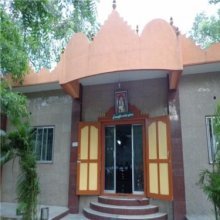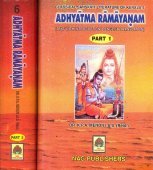Ashrama, Āśrama, Aśrama: 34 definitions
Introduction:
Ashrama means something in Hinduism, Sanskrit, Jainism, Prakrit, the history of ancient India, Marathi, Hindi. If you want to know the exact meaning, history, etymology or English translation of this term then check out the descriptions on this page. Add your comment or reference to a book if you want to contribute to this summary article.
The Sanskrit terms Āśrama and Aśrama can be transliterated into English as Asrama or Ashrama, using the IAST transliteration scheme (?).
Images (photo gallery)
(+8 more images available)
In Hinduism
Purana and Itihasa (epic history)
Source: archive.org: Puranic EncyclopediaĀśrama (आश्रम).—Asramites (Inmates of an Āśrama) have to pass through four stages. The four stages of Brahmacarya, Gārhasthya, Vānaprastha and Sannyāsa are known as the four Āśramas. Viṣṇu Purāṇa, Part III, Chapter 9 describes each of the Āśramas as follows: Brahmacarya. "After Upanayana a boy should maintain a Brahmacārī’s vrata, engage himself in the study of the Vedas, suppress his indriyas (the five senses) and live in the house of the preceptor. Living there with proper observance of śauca, customs and vratas he should serve and attend on the Guru. The study of Vedas should be with proper observance of Vratas and steady attention. A Brahmacārī should worship with concentration, the Sun and Agni at the time of the two sandhyās (dawn and dusk) and after that he should do obeisance to the Guru. When the Guru stands, he should also be standing. When the guru walks, he should walk behind him and when he sits, he should sit in a lower position. The Śiṣya (disciple-pupil) should not do anything against the guru. When the guru himself asks, the Śiṣya should sit in front of him and recite Vedas without attending to anything else. After that, with his permission he may eat food which has been got by begging. The Śiṣya may take his bath in the water only after the Ācārya (guru) has taken his bath in it. Everyday the Camata, darbha, water and flowers which the guru needs, must be brought and supplied (by the Śiṣya). (See full article at Story of Āśrama from the Puranic encyclopaedia by Vettam Mani)
Source: Cologne Digital Sanskrit Dictionaries: The Purana IndexĀśrama (आश्रम).—(āśramadharma)—four, brahmacarya, gṛhasta, vānaprastha and bhikṣuka; duties:—brahmacarya study by service to guru and begging food; gṛhasta the source and strength of all āśramas; those celibate do penance, sacrifice, give birth to sons, perform śrāddha, learn the Vedas and give gifts of food; dārāgni, guests, sacrifice and śrāddha; become devapitṛs; vānaprastha bathe in morning and evening and on ceremonials; eating of fruits and roots, non-theft, purity, sympathy and non-injury—ten kinds of dharma; bhikṣu: daṇḍi, mekhali, and lying in ground floor.1 A reference to the fifth āśrama;2 will be lost at the end of Kaliyuga when anarchy prevails.3
- 1) Bhāgavata-purāṇa VII. 12. 1-31; 13. 1-10; 14. to the end; Matsya-purāṇa 141. 61-2; 248. 16; Vāyu-purāṇa 8. 177-88; 23. 82; 33. 27; 56. 68; 61. 167; Viṣṇu-purāṇa III. 8. 20; ch. 9 (whole).
- 2) Brahmāṇḍa-purāṇa II. 16. 15; III. 15. 37-8.
- 3) Matsya-purāṇa 47. 257.

The Purana (पुराण, purāṇas) refers to Sanskrit literature preserving ancient India’s vast cultural history, including historical legends, religious ceremonies, various arts and sciences. The eighteen mahapuranas total over 400,000 shlokas (metrical couplets) and date to at least several centuries BCE.
Vaishnavism (Vaishava dharma)
Source: Prabhupada Books: Sri Caitanya CaritamrtaĀśrama (आश्रम).—The spiritual orders-brahmacarya, gṛhastha, vānaprastha and sannyāsa are called āśramas. If one executes his prescribed duty in both the social and spiritual order, the Supreme Personality of Godhead is satisfied. If one neglects his duties, however, he becomes a transgressor and a candidate for a hellish condition.
Source: Pure Bhakti: Bhagavad-gita (4th edition)Āśrama (आश्रम) refers to “(1) Stage of life, either student (brahmacārī), householder (gṛhastha), retired (vānaprastha) or renounced (sannyāsa) (2) Hermitage”. (cf. Glossary page from Śrīmad-Bhagavad-Gītā).
Source: Pure Bhakti: Bhajana-rahasya - 2nd EditionĀśrama (आश्रम) refers to:—One of the four stages of life: brahmācārī, gṛhastha, vānaprastha and sannyāsa. (cf. Glossary page from Bhajana-Rahasya).
Source: Pure Bhakti: Arcana-dipika - 3rd EditionĀśrama (आश्रम) refers to the “four stages of life”, according to the Arcana-dīpikā (manual on deity worship).—It is mentioned in various śāstras that a person belonging to any of the four occupational divisions (varṇas) or four stages of life (āśramas) has the right to become a Vaiṣṇava by accepting the viṣṇu-mantras and then engaging in the worship of Śrī Viṣṇu.

Vaishnava (वैष्णव, vaiṣṇava) or vaishnavism (vaiṣṇavism) represents a tradition of Hinduism worshipping Vishnu as the supreme Lord. Similar to the Shaktism and Shaivism traditions, Vaishnavism also developed as an individual movement, famous for its exposition of the dashavatara (‘ten avatars of Vishnu’).
Dharmashastra (religious law)
Source: Knowledge Traditions & Practices of India: Education: Systems & PracticesĀśrama (आश्रम) refers to secluded areas the gurukulas (teacher’s house) were located, forming part of the ancient Indian education system, which aimed at both the inner and the outer dimension of a person. The secluded, often forested areas, where gurukulas were generally located were known as āśramas. These āśramas bore the name of the guru. Ancient texts mention many such āśramas where pupils gathered and lived with the teacher.
Source: Shodhganga: The saurapurana - a critical study (dharma)Āśrama (आश्रम) refers to the “four stages of life” of ancient India, according to the 10th century Saurapurāṇa: one of the various Upapurāṇas depicting Śaivism.— The word āśrama is derived from śram to exert, to labour, and etymologically means to a stage in which one exerts oneself. From the times of the most ancient dharmaśāstras the number of āśramas has been four:—Brahmacarya, Gṛhastha, Vānaprastha and Sannyāsa (Sannyāsin).
The first part of āśrama [i.e. man’s life] is brahmacarya in which he learns at his teacher’s house and after he has finished his study, in the second part of his life, he marries and becomes a house holder (gṛhastha), discharges his debts to his ancestors by begetting sons and to the gods by performing sacrifices. When he sees that his head has grey hair and that there are wrinkles on his, body he resorts to the forest i.e. he becomes a vānaprastha. After spending the third part of his life in the forest for some times he spends the rest of his life as a sannyāsin.
The scheme of the āśrama is based on the ethical principle that man should discharge his duties fully before aspiring for liberation from the bonds of the flesh and the world. The path of duty is the way to glory. Before desiring to be absolved from the bonds of existence he has to absolve himself from the threefold debt he owes to the sages, gods and ancestors. He does it by Vedic study, through sacrifice and through progeny. The first two stages, Brahmacarya and Gārhasthya offer the aspirant ample scope for discharging these debts. And by discharging them he contributes to the progress of society in its intellectual, economic and numerical aspects.

Dharmashastra (धर्मशास्त्र, dharmaśāstra) contains the instructions (shastra) regarding religious conduct of livelihood (dharma), ceremonies, jurisprudence (study of law) and more. It is categorized as smriti, an important and authoritative selection of books dealing with the Hindu lifestyle.
Arthashastra (politics and welfare)
Source: Knowledge Traditions & Practices of India: Indian Ethics: Individual and SocialĀśrama (आश्रम) refers to “stage of life”.—In the Hindu way of life, every individual is expected to perform his or her duty appropriate to his or her caste (varṇa) and stage of life (āśrama). This division of one’s life into the four āśramas and their respective dharmas, was designed, in principle at least, to provide fulfilment to the person in his social, moral and spiritual aspects, and so to lead to harmony and balance in the society.
The four āśramas are:
- brahmacarya, stage of studentship;
- gṛhastha, stage of the householder;
- vanaprastha, life in the forest;
- saṃnyāsa, renunciation.

Arthashastra (अर्थशास्त्र, arthaśāstra) literature concerns itself with the teachings (shastra) of economic prosperity (artha) statecraft, politics and military tactics. The term arthashastra refers to both the name of these scientific teachings, as well as the name of a Sanskrit work included in such literature. This book was written (3rd century BCE) by by Kautilya, who flourished in the 4th century BCE.
Shaktism (Shakta philosophy)
Source: Google Books: ManthanabhairavatantramĀśrama (आश्रम) refers to the “divine abode” of the Goddess, according to Tantric texts such as the Kubjikāmata-tantra, the earliest popular and most authoritative Tantra of the Kubjikā cult.—The central and most important events in the myth narrated in the Kubjikāmatatantra are the goddess’s assumption of the form of a Liṅga and her emergence from it. [...] According to the Manthānabhairavatantra, this Liṅga is an aggregate of the Goddess’s energies and is the divine abode (āśrama) of the Command, just as the maṇḍala is that of the deity. Indeed the Liṅga is a form of the Command which, free in every way of ignorance, is the authority of the tradition transmitted through the lineages of teachers.

Shakta (शाक्त, śākta) or Shaktism (śāktism) represents a tradition of Hinduism where the Goddess (Devi) is revered and worshipped. Shakta literature includes a range of scriptures, including various Agamas and Tantras, although its roots may be traced back to the Vedas.
Vastushastra (architecture)
Source: Brill: Śaivism and the Tantric Traditions (architecture)Āśrama (आश्रम) (Cf. Gṛha) refers to a “residence”, according to the Devyāmata (chapter 105).—Accordingly, [while describing the construction of residence for initiates]—“A residence (gṛha) is recommended to the south of the temple. The residence (āśrama) should be built beyond the outer wall of the temple. It is to be dwelt in by initiates, their senses well-subordinated, who have come to the image. Or, in its absence, [they should dwell in] another pleasant place. [...]”.

Vastushastra (वास्तुशास्त्र, vāstuśāstra) refers to the ancient Indian science (shastra) of architecture (vastu), dealing with topics such architecture, sculpture, town-building, fort building and various other constructions. Vastu also deals with the philosophy of the architectural relation with the cosmic universe.
Ganitashastra (Mathematics and Algebra)
Source: archive.org: Hindu MathematicsAśrama (अश्रम) represents the number 4 (four) in the “word-numeral system” (bhūtasaṃkhyā), which was used in Sanskrit texts dealing with astronomy, mathematics, metrics, as well as in the dates of inscriptions and manuscripts in ancient Indian literature.—A system of expressing numbers by means of words arranged as in the place-value notation was developed and perfected in India in the early centuries of the Christian era. In this system the numerals [e.g., 4—aśrama] are expressed by names of things, beings or concepts, which, naturally or in accordance with the teaching of the Śāstras, connote numbers.

Ganitashastra (शिल्पशास्त्र, gaṇitaśāstra) refers to the ancient Indian science of mathematics, algebra, number theory, arithmetic, etc. Closely allied with astronomy, both were commonly taught and studied in universities, even since the 1st millennium BCE. Ganita-shastra also includes ritualistic math-books such as the Shulba-sutras.
Yoga (school of philosophy)
Source: ORA: Amanaska (king of all yogas): A Critical Edition and Annotated Translation by Jason BirchĀśrama (आश्रम) refers to “religious disciplines”, according to the Sarvajñānottara verse 20.34-39.—Accordingly, while discussing the culmination of detachment (for the process of attaining the no-mind state): “Having abandoned those feelings connected with his region, caste, his caste-class and religious disciplines (āśrama), the wise should meditate on his own [inner] state. Abandoning all such feelings as ‘this is [my] mantra’, ‘this is [my] deity’, ‘this is [my] meditation’ [or] ‘this is [my] austerity’, he should meditate on his own [inner] state. [...]”.

Yoga is originally considered a branch of Hindu philosophy (astika), but both ancient and modern Yoga combine the physical, mental and spiritual. Yoga teaches various physical techniques also known as āsanas (postures), used for various purposes (eg., meditation, contemplation, relaxation).
Shaivism (Shaiva philosophy)
Source: HAL: The function of the Vṛṣasārasaṃgraha in the Śivadharma corpusĀśrama (आश्रम) refers to the classification of the traditional way of life, according to various sources. It is generally accepted that one of the defining marks of the Brahmanical religion is the system of four Āśrama. The system of the four Brahmanical Āśramas also survived practically intact during the time of the Tantric and non-Tantric manifestations of Śaivism and Vaiṣṇavism
The editor of the Trivandrum edition of the Pāśupatasūtra gives the following list in explanation of the phrase ‘Six Āśramas’ (ṣaḍ-āśrama):
- Brahmacārī,
- Gṛhastha,
- Vānaprastha,
- Saṃnyāsī,
- Pāṣaṇḍa and
- Siddha.
This interpretation is probably based on Kauṇḍinya ad Pāśupatasūtra 1.6 and 4.18 (“the paths of the householder, the chaste student, the forest-dweller, the mendicant, and the heretic are wrong paths”).
Another obscure mention of Six Āśramas appears at Jayadrathayāmala 1.45.213ab (fol. 194r):—“He who is established within the Six Āśramas is the [true] Guru in the Bhairava Tradition”.
Furthermore, the Nityāhnikatilaka (NGMPP 3384, A 41/11, fols 2r–3r), a post-tenth-century text of the Kubjikā tradition, teaches Six Āśramas mostly intended for Yogins, namely:
- Gṛhastha,
- Sālayin,
- Cāravin,
- Vanacārin,
- Naiṣṭhaka and
- Yogin.

Shaiva (शैव, śaiva) or Shaivism (śaivism) represents a tradition of Hinduism worshiping Shiva as the supreme being. Closely related to Shaktism, Shaiva literature includes a range of scriptures, including Tantras, while the root of this tradition may be traced back to the ancient Vedas.
General definition (in Hinduism)
Source: A Handful of Leaves: The Āśrama SystemThe four āśramas (आश्रम) are the modes of life of a celibate student, a married householder, a forest hermit, and a world renouncer. Brāhmaṇical theology considers these āśramas as constitutive and interrelated parts of an organic whole made up of the rules (dharmas) that govern human conduct; this organic whole is often simply referred to as dharma.
Source: Texas Liberal Arts: Āśrama and SaṃnyāsaThe term Āśrama (आश्रम) has two related meanings. The first is that of a residence, often located in forests, where holy people live and perform religious austerities (→ tapas). This is by far its most common meaning; it is so used in Brahmanical, Buddhist, and Jain literary sources, as well as in nonreligious texts such as drama, poetry, and fables.
The second meaning of the term is that of a religiousor holy way of life. The latter is, in all likelihood, a technical usage, as it occurs exclusively in Brāhmaṇical literature and mainly within thecontext of the āśrama system.
In Jainism
General definition (in Jainism)
Source: archive.org: Jaina YogaĀśrama (आश्रम).—Amongst the Digambaras Cāmuṇḍarāya has taken over the Hindu concept of the four āśramas, which, following Jinasena, he terms brahmacārin, gṛhastha, vānaprastha, and bhikṣu.

Jainism is an Indian religion of Dharma whose doctrine revolves around harmlessness (ahimsa) towards every living being. The two major branches (Digambara and Svetambara) of Jainism stimulate self-control (or, shramana, ‘self-reliance’) and spiritual development through a path of peace for the soul to progess to the ultimate goal.
India history and geography
Source: Cologne Digital Sanskrit Dictionaries: Indian Epigraphical GlossaryĀśrama.—(EI 13) a stage of life; a religious establishment (Ep. Ind., Vol. XXX, p. 67); cf. Caṇḍika-aśrama-guru (IA 11), ‘the Superior of the hermitage of Caṇḍikā’. (IE 7-1-2), ‘four’. Note: āśrama is defined in the “Indian epigraphical glossary” as it can be found on ancient inscriptions commonly written in Sanskrit, Prakrit or Dravidian languages.
Source: Singhi Jain Series: Ratnaprabha-suri’s Kuvalayamala-katha (history)Aśrama (अश्रम) refers to the Hermitages of ancient India, where one could Study (the tenets of religion and philosophy) and pursue the spiritual life, as vividly depicted in the Kathās (narrative poems) such as Uddyotanasūri in his 8th-century Kuvalayamālā (a Prakrit Campū, similar to Kāvya poetry).—The Kuvalayamala (779 A.D.) is full of cultural material which gains in value because of the firm date of its composition. [...] Page 87.20-28: Here is a vivid description of the intellectual and spiritual life in the Aśrama of a Jaina Muni, somewhat similar to that in the hermitage of Divākara Mitra described by Bāṇa in the Harṣacarita where scholars studied, devoted and held controversies, disputations and exchange of views on several points of religion and philosophy.[...].

The history of India traces the identification of countries, villages, towns and other regions of India, as well as mythology, zoology, royal dynasties, rulers, tribes, local festivities and traditions and regional languages. Ancient India enjoyed religious freedom and encourages the path of Dharma, a concept common to Buddhism, Hinduism, and Jainism.
Languages of India and abroad
Marathi-English dictionary
Source: DDSA: The Molesworth Marathi and English Dictionaryāśrama (आश्रम).—m (S) A religious order. There are four kinds, referable to the four ages of life; viz. brahma- carya, gārhasthya, vānaprasthya, sannyāsa. 2 A hermitage, an abode of saints and sages. 3 An order among Gosavis.
Source: DDSA: The Aryabhusan school dictionary, Marathi-Englishāśrama (आश्रम).—m A religious order. A hermitage.
Marathi is an Indo-European language having over 70 million native speakers people in (predominantly) Maharashtra India. Marathi, like many other Indo-Aryan languages, evolved from early forms of Prakrit, which itself is a subset of Sanskrit, one of the most ancient languages of the world.
Sanskrit dictionary
Source: DDSA: The practical Sanskrit-English dictionaryAśrama (अश्रम).—a. Ved. Indefatigable, untiring. Ṛgveda 7.69.7.
-maḥ 1 Freedom from fatigue, freshness, vigour.
2) Absence of toil, laziness.
--- OR ---
Āśrama (आश्रम).—[ā-śram ādhāre ghañ vṛddhayabhāvaḥ]
1) A hermitage, hut, cell, dwelling or abode of ascetics; शरणान्यशरण्यानि आश्रमाणि कृतानि नः (śaraṇānyaśaraṇyāni āśramāṇi kṛtāni naḥ) Rām.7.6.5.
2) A stage, order, or period of the (religious) life of a Brāhmaṇa (These are four:-brahmacarya the life of a student; gārhasthya the life of a house-holder; vānaprastha the life of an anchorite or hermit, and saṃnyāsa the life of a Bhikṣu or beggar. Kṣatriyas (and Vśiyas also) can enter, upon the first three Āśramas; cf. Ś.7.18; V.5; (according to some authorities they can enter the fourth also; cf. sa kilāśramamantyamāśritaḥ R.8.14; pūrvāśramaḥ Kumārasambhava 5.5.
3) A college, school.
4) A wood or thicket (where ascetics practise penance).
5) Name of Viṣṇu.
Derivable forms: āśramaḥ (आश्रमः), āśramam (आश्रमम्).
Source: Cologne Digital Sanskrit Dictionaries: Shabda-Sagara Sanskrit-English DictionaryAśrama (अश्रम).—m.
(-maḥ) 1. Freshness, freedom from fatigue. 2. Laziness, want of exertion. E. a neg. śrama fatigue.
--- OR ---
Āśrama (आश्रम).—m.
(-maḥ) 1. A religious order, of which there are four kinds referable to the different periods of life; 1st, that of the student or Brahmachari; 2d, that of the householder or Grihast'ha; 3d, that of the anchorite or Vanaprast'ha; and 4th, that of the beggar or Bhikshu; see brahmacārī, &c. 2. A college, a school. 3. A hermitage, the abode of retired saints or sages. 4. A wood or thicket. E. āṅ before śrama to perform religious austerities, affix ghañ.
Source: Cologne Digital Sanskrit Dictionaries: Benfey Sanskrit-English DictionaryĀśrama (आश्रम).—[ā-śram + a], m. and n. 1. An hermitage. 2. A religious order of which there are four (or only three, [Mānavadharmaśāstra] 2, 230) kinds referable to the different periods of a Brāhmaṇa’s life, [Mānavadharmaśāstra] 3, 2.
--- OR ---
Aśrama (अश्रम).—m. absence of weariness, [Raghuvaṃśa, (ed. Stenzler.)] 2, 67.
Aśrama is a Sanskrit compound consisting of the terms a and śrama (श्रम).
Source: Cologne Digital Sanskrit Dictionaries: Cappeller Sanskrit-English DictionaryAśrama (अश्रम).—1. [masculine] absence of fatigue.
--- OR ---
Aśrama (अश्रम).—[adjective] unwearied, indefatigable.
--- OR ---
Aśrama (अश्रम).—2. [adjective] unwearied, indefatigable.
--- OR ---
Āśrama (आश्रम).—[masculine] hermitage; one of the (four) orders of religious life (also pada [neuter]).
Source: Cologne Digital Sanskrit Dictionaries: Monier-Williams Sanskrit-English Dictionary1) Aśrama (अश्रम):—[=a-śrama] mfn. indefatigable, [Ṛg-veda vii, 69, 7]
2) [v.s. ...] idem, [Ṛg-veda vi, 21, 12]
3) Asrāma (अस्राम):—[=a-srāma] mf(ā)n. not lame, [Atharva-veda i, 31, 3]
4) [v.s. ...] not withered, [Gobhila-śrāddha-kalpa]
5) Āśrama (आश्रम):—[=ā-śrama] mn. (√śram), a hermitage, the abode of ascetics, the cell of a hermit or of retired saints or sages, [Manu-smṛti; Rāmāyaṇa; Daśakumāra-carita; Raghuvaṃśa; Meghadūta] etc.
6) [v.s. ...] a stage in the life of a Brāhman (of which there are four corresponding to four different periods or conditions, viz. 1st, Brahmacārin, ‘student of the Veda’; 2nd, Gṛha-stha, ‘householder’; 3rd, Vānaprastha, ‘anchorite’; and 4th, Saṃnyāsin, ‘abandoner of all worldly concerns’, or sometimes Bhikṣu, ‘religious beggar’; in some places the law-givers mention only three such periods of religious life, the first being then omitted), [Manu-smṛti; Rāmāyaṇa; Suśruta; Raghuvaṃśa] etc.
7) [v.s. ...] a hut built on festal occasions, [Varāha-mihira’s Bṛhat-saṃhitā]
8) [v.s. ...] a college, school
9) [v.s. ...] a wood or thicket, [cf. Lexicographers, esp. such as amarasiṃha, halāyudha, hemacandra, etc.]
10) [v.s. ...] m. Name of a pupil of Pṛthvī-dhara.
Source: Cologne Digital Sanskrit Dictionaries: Yates Sanskrit-English Dictionary1) Aśrama (अश्रम):—[a-śrama] (maḥ) 1. m. Untiredness.
2) Āśrama (आश्रम):—[ā-śrama] (maḥ) 1. m. A religious order; a hermitage; a school; a wood.
Source: DDSA: Paia-sadda-mahannavo; a comprehensive Prakrit Hindi dictionary (S)Āśrama (आश्रम) in the Sanskrit language is related to the Prakrit words: Assama, Āsama.
[Sanskrit to German]
Sanskrit, also spelled संस्कृतम् (saṃskṛtam), is an ancient language of India commonly seen as the grandmother of the Indo-European language family (even English!). Closely allied with Prakrit and Pali, Sanskrit is more exhaustive in both grammar and terms and has the most extensive collection of literature in the world, greatly surpassing its sister-languages Greek and Latin.
Hindi dictionary
Source: DDSA: A practical Hindi-English dictionaryĀśrama (आश्रम) [Also spelled asram]:—(nm) hermitage; abode; one of the four stages in the life of caste Hindus (viz. brahmachary —as a student of the Vedas; Grihasth —as a householder; Vanprasth —as abandoner of worldly things; Sannyas —as an anchorite); ~[vāsī] a hermit, inmate of an [āśrama].
Source: DDSA: A practical Hindi-English dictionaryAsram in Hindi refers in English to:—(nm) hermitage; abode; one of the four stages in the life of caste Hindus (viz. brahmachary —as a student of the Vedas; Grihasth —as a householder; Vanprasth —as abandoner of worldly things; Sannyas —as an anchorite); ~[vasi] a hermit, inmate of an [ashrama]..—asram (आश्रम) is alternatively transliterated as Āśrama.
...
Kannada-English dictionary
Source: Alar: Kannada-English corpusAśrama (ಅಶ್ರಮ):—[adjective] not tired; not becoming weary; indefatigable.
--- OR ---
Aśrama (ಅಶ್ರಮ):—[noun] easiness; absence of fatigue; effortlessness.
--- OR ---
Āśrama (ಆಶ್ರಮ):—
1) [noun] a hut or the region where sages live; hermitage.
2) [noun] an abode for specific purpose (as in ವೃದ್ಧಾಶ್ರಮ [vriddhashrama]) 3) any of the four orders, stages or periods in the religious life of a Brāhmaṇa.
3) [noun] a school, usu. with an attached residence for the students; a hermit residential school.
Kannada is a Dravidian language (as opposed to the Indo-European language family) mainly spoken in the southwestern region of India.
Nepali dictionary
Source: unoes: Nepali-English DictionaryĀśrama (आश्रम):—n. 1. hermitage; hut; cell; dwelling or abode of ascetics; 2. a stage; order/the period of the (religious) life of a Brahmana; 3. a school/college; 4. a wood or thicjrt (where ascetics practise penance); 5. Mythol. name of Vishnu;
Nepali is the primary language of the Nepalese people counting almost 20 million native speakers. The country of Nepal is situated in the Himalaya mountain range to the north of India.
See also (Relevant definitions)
Starts with (+11): Ashramabhrashta, Ashramacara, Ashramacatushtaya, Ashramadharma, Ashramadharmma, Ashramaguru, Ashramalakshana, Ashramalakshma, Ashramalaya, Ashramalinga, Ashramamandala, Ashramana, Ashramanaka, Ashramantara, Ashramantaragata, Ashramanya, Ashramapada, Ashramaparvan, Ashramapati, Ashramasad.
Ends with (+152): Acyutashrama, Adhikashrama, Adhvashrama, Adityasyashrama, Agastyashrama, Akritashrama, Amalananda vyasashrama, Amgashrama, Anandashrama, Anantashrama, Anashrama, Anathashrama, Anjalikashrama, Apashrama, Atrikashrama, Atyashrama, Avadhutashrama, Badarikashrama, Badariyashrama, Badaryashrama.
Full-text (+424): Vanaprastha, Grihastha, Varnashrama, Ashramapada, Atyashramin, Anashramin, Ashramin, Ashramadharma, Samnyasa, Ashramika, Ashramamandala, Ashramaguru, Yathashramam, Brahmacarin, Ashramavasin, Ashramaparvan, Ashramasthana, Ashramavidambaka, Grihashrama, Sarvashramin.
Relevant text
Search found 152 books and stories containing Ashrama, Āśrama, Aśrama, A-srāma, A-srama, A-śrama, Asrāma, A-shrama, Asrama, Ā-śrama, Ashram, Asram; (plurals include: Ashramas, Āśramas, Aśramas, srāmas, sramas, śramas, Asrāmas, shramas, Asramas, Ashrams, Asrams). You can also click to the full overview containing English textual excerpts. Below are direct links for the most relevant articles:
Garga Samhita (English) (by Danavir Goswami)
Verses 4.15.16-17 < [Chapter 15 - The Story of the Women of Barhiṣmatī-pura, the Apsarās, and the Women of Sutala and Nāgendra]
Verse 1.4.48 < [Chapter 4 - Description of Questions About the Lord’s Appearance]
Verse 2.13.5 < [Chapter 13 - The Story of Śeṣa]
Brahma Sutras (Shankara Bhashya) (by Swami Vireshwarananda)
Chapter III, Section IV, Adhikarana VIII < [Section IV]
Chapter III, Section IV, Adhikarana IX < [Section IV]
Chapter III, Section IV, Adhikarana X < [Section IV]
Shri Gaudiya Kanthahara (by Srila Bhaktisiddhanta Sarasvati)
Hari-bhakti-kalpa-latikā (by Sarasvati Thkura)
Text 30 < [First Stabaka]
Harshacharita (socio-cultural Study) (by Mrs. Nandita Sarmah)
Part 5: Different Stages of the Life or Āśrama Vyavasthā < [Chapter 2 - Caste System]
Part 2: Formal Education and Informal Education < [Chapter 3 - Education System]
1. Similarities (4): Caste and Āśrama < [Chapter 8 - Comparative Society as described in the Kādambarī and the Harṣacarita]
The Markandeya Purana (Study) (by Chandamita Bhattacharya)
Related products











